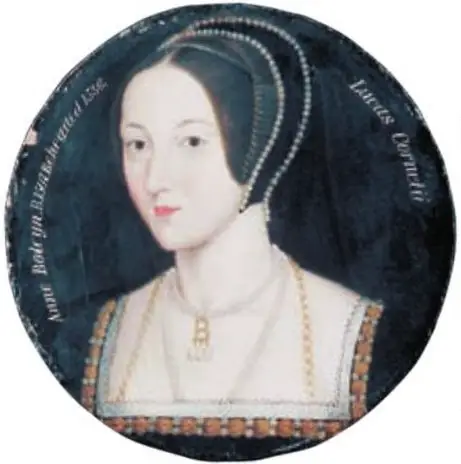Part of what fascinates me about Anne Boleyn is the mystery that surrounds her. We do not even know, definitively, what she looked like and can only go on contemporary descriptions and portraiture. The problem with portraits of Anne Boleyn is that they are all so different and none are thought to be contemporary, but, instead, are thought to be later copies of earlier works, which were destroyed when Anne fell from power, or to have been painted during Elizabeth I’s reign. We are left asking “what did Anne Boleyn look like?” and which portrait shows the true Anne Boleyn?
If you compare the National Portrait Gallery iconic portrait to the sketches by Holbein and the miniature by Lucas Horenbolte, they look like three very different women.
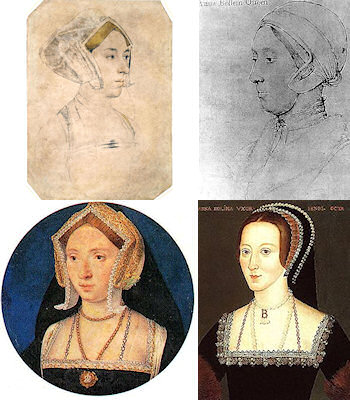
(Click here to see a high resolution copy of this image.)
The first three show a rather plain woman with a double chin and rather unfashionable attire, yet the final portrait shows a stylish and attractive young woman – surely they can’t all be Anne Boleyn!
Argument for Holbein’s Sketch
In their article “An old tradition reasserted: Holbein’s portrait of Queen Anne Boleyn”, John Rowlands and David Starkey argue that the chalk drawing by Hans Holbein, inscribed “Anna Bollein Queen” (see below), is the true face of Anne Boleyn. Rowlands and Starkey state that although this sketch has been rejected in the past by the likes of K T Parker, who argued that “the features show . .. no resemblance whatever with the well authenticated drawing of Anne Boleyn in Lord Bradford’s possession” (see the first image in “The 4 Faces of Anne Boleyn picture), the Holbein drawing could be Anne because:-
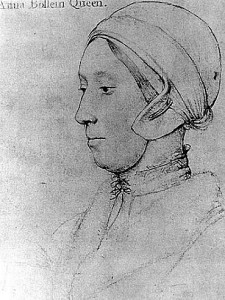
- It matches some contemporary descriptions of Anne Boleyn, e.g. a French account of Anne’s entry into London on the 31st May 1533 (her coronation) described her as scrofulous (scrofula is s form of tuberculosis affecting the lymph nodes, especially of the neck) and wearing a dress which was fastened high up on the throat to hide this swelling. Starkey and Rowlands note that “in the drawing her double chin is so pronounced as to suggest such a swelling of the throat glands, which is indeed partly hidden by a high neckline.”
- The sitter’s dress – Rowlands and Starkey note that the sitter is in a state of undress and is just wearing a chemise with a furred nightgown and an undercap. They believe that “only a woman of the very highest rank could have taken such a liberty in court circles” and that it speaks of the “royalty” of the sitter.
- The inscription “Anna Bollein Queen” – They state that, according to the Lumley Inventory, this inscription was “subscribed” by Sir John Cheke, Edward VI’s tutor and friend of William Butts, Henry VIII’s physician and a man whose patron was Anne Boleyn. Rowlands and Starkey write “Cheke must have known Anne, and most of
those he lived and worked with at court would have known her too. Of all the identifications he made it seems inconceivable that he could have been mistaken about this one.” - Anne Boleyn’s connection with Holbein – Hans Holbein designed montages for Anne Boleyn’s coronation procession in 1533, he designed jewellery in which the King’s and Anne’s initials are combined, and together with Cornelius Heyss (the King’s goldsmith) he created a cradle for the King and Queen in 1533 for the baby that Anne was expecting in the September, the longed for boy who turned out to be a girl. Rowlands and Starkey argue that although Holbein only received full royal recognition after Anne’s fall in 1536, “his appointment as the King’s Painter probably antedates it. And the likely responsibility rests with Anne Boleyn herself.” It is likely therefore that the sketch IS of Anne Boleyn.
Arguments Against Holbein’s Sketch
In his article “A Reassessment of Queen Anne Boleyn’s Portraiture”, Roland Hui argues that “it seems unlikely that Anne with her much commented upon sense of style would have permitted to be depicted as such” and that “to believe that Anne was goitrous (not to mention deformed by a large wart says the writer), one would also have to accept the ridiculous fiction that at her crowning she also wore a dress covered with a sinister motif of tongues pierced with nails ‘to show the treatment which those who spoke against her might expect.’ ” I have to agree with Hui, I cannot believe that a man like Henry VIII would wait 7 years and break with Rome for the woman pictured in that chalk sketch. I know that Anne was not a classic beauty but she was known for her magnetism and her style, which is sadly lacking in that sketch.
In “The Life and Death of Anne Boleyn”, Eric Ives points out that Sir John Cheke, who was said to have identified the sketch as Anne Boleyn, was incorrect in several of his identifications of other portraits, so “the Cheke story is suspect”. Ives also argues against the British museum Holbein sketch and the chalk drawing being Anne Boleyn because the portrait medal of 1534, the only contemporary likeness of Anne Boleyn, shows a long and oval face with high cheekbones, features that just aren’t there in the sketches. Ives concludes that “judged by the medal, Anne sat for neither of the Holbein drawings.” Roland Hui also points out that we know that Anne was dark haired but the first sketch is of a blonde woman.
Roy Strong’s Anne Boleyn
Roy Strong, the eminent art historian, has suggested that the Lucas Horenbolte (Horenboute) miniature of an Unknown Woman c1526/1527 is Anne Boleyn because the appearance of the woman is “perfectly compatible” with the Anne Boleyn seen in the National Portrait Gallery painting. However, Roland Hui argues that “it is difficult to reconcile the two likenesses – the NPG type of Anne with her long face and high cheekbones versus Horenbolte’s lady with her broader features and double chin” and suggests that the sitter may, in fact, be Mary Boleyn. Eric Ives also dismisses Strong’s theory, arguing that the image is unlike that of the Elizabeth I locket ring and that miniatures of that time were usually limited to royal persons and Anne was not royal at this time.
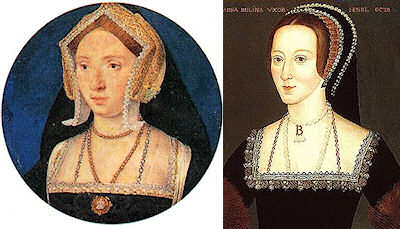
The Nidd Hall Anne Boleyn
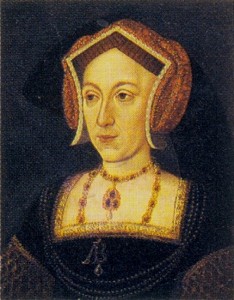
The Nidd Hall portrait showing a woman similar to Holbein’s Jane Seymour but with an AB brooch has been identified as “The Most Excellent Princesse Anne Boleyn” but Roland Hui argues that her likeness has been derived from Henry VIII’s third wife, Jane Seymour. He notes that a variant of this portrait, an engraving by Renold Elstrack, showed the sitter with a squared jeweled tablet rather than an AB brooch, and that “the facial features found in the engraving and in the Nidd Hall picture are actually more in line with the Whitehall Jane’s than those of the NPG Anne.”
If you hid the AB brooch and showed the portrait to a Tudor history fan and asked them who it was, I’m pretty sure they’d identify it as Jane Seymour, so I have to agree with Hui who concludes that Elstrack based his engraving on a Nidd Hall type panel which had been misidentified as Jane. He also wonders if a demand fro Anne Boleyn images in Elizabeth I’s reign led to images of Jane Seymour, of whom there were many likenesses, being relabelled as Anne.
Eric Ives and the Real Anne Boleyn
In “The Life and Death of Anne Boleyn”, Eriv Ives writes of how there is “a resolution of this pictorial game of ‘find the lady’ ” and that the key to it is the Chequers locket ring which belonged to Elizabeth I. This ring contains two enamel portraits – one of Elizabeth and one of her mother, Anne Boleyn – and Ives writes of how “the face mask is quite clearly that of the sitter in the Hever and National Portrait Gallery paintings.” Ives goes on to say that both the Chequers enamel and the 1534 portrait medal show a woman with a “long oval face, high cheek-bones, strong nose and a decided chin: a face of character, not beauty” and that “there is thus an authenticated sequence for Anne Boleyn, comprising the medal, the Chequers enamel and the Hever/NPG pattern.”
Ives also mentions the miniature attributed to the 17th century miniaturist, John Hoskins, which was said to have been copied “from an ancient original”. Ives concludes that Hoskins had access to an earlier image, probably the same image that the NPG portrait is based on and wonders if the miniature and portrait are actually based on a lost Holbein because in 1590 Lord Lumley owned a full-length portrait of Anne Boleyn and we know that it existed as late as 1773. Whatever the original inspiration for the Hoskins miniature, Ives believes that “it is the best depiction of Anne we are ever likely to have, failing the discovery of new material” and concludes:-
“Portrait medal – Chequers ring – Hever/NPG pattern – Hoskins miniature: the chain is complete. We have the real Anne Boleyn.”
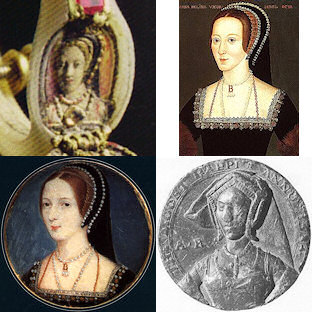
Roland Hui and the NPG Portrait
Hui agrees with Ives about the NPG portrait being a true likeness of Anne Boleyn. He states that although it has often been discounted because it dates back to the late 16th century, during Elizabeth I’s reign, costume evidence goes in its favour. In the portrait, the woman is “fashionably attired unlike the lady of the Windsor drawing [the chalk sketch]” in a black gown with a gold decorated collar and a stylish French hood with pearled billiments. Hui points out that black was one of Anne’s preferred colours for gowns as shown in royal expenses and we know that Anne was fond of the French Hood, rather than the English style Gable Hood. Hui goes on to say that the painting’s correlation to two works by the Flemish artist Lucas Horenbolte and the Hever Castle rose portrait establish “the NPG type as a portrait derived from Anne’s own lifetime”.
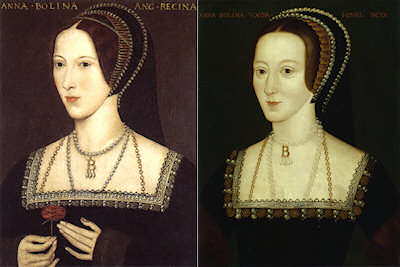
The Hever Rose Portrait and Horenbolte
Hui writes that “what authenticates the NPG painting as a true likeness of Anne Boleyn, is a copy of this type at Hever Castle.” If we compare the two portraits there are similarities:-
- The French Hood is the same
- The dress has the same colouring and collar
- The B necklace and gold chain are the same
- The sitter has the same long face, high cheekbones and long nose
The main difference between the two is the position of the hands which, in the Hever portrait, are placed across the breast with one holding a red rose. Hui writes that this positioning of the sitter is reminiscent of a portrait of an Unknown Woman attributed to Horenbolte and thought to be Margaret Pole, the Countess of Salisbury, where the sitter has her hands at her breast holding a girdle or pomander, and of the Horenbolte miniature of Catherine of Aragon where Catherine is offering a scrap of food to her pet monkey.
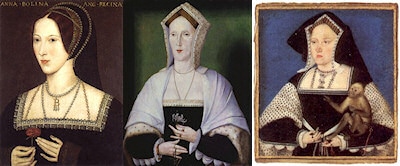
Why is this feature of the painting so important?
Because, according to Hui, this custom of placing the hands in this way was only fashionable in Tudor portraiture in the 1520’s and 1530’s. Hui concludes, therefore, that “the NPG/Hever type of Anne was painted from life with the Queen formally posed in the then current fashion” and that “these clues point to Horenbolte as the originator of the NPG type image of Anne Boleyn”, after all, he was in royal service by 1531 and may well have received patronage from the Boleyn family or from William Carey, Anne’s brother-in-law, before that time.
My Anne Boleyn
We all have our favourite Anne Boleyn portraits don’t we? Well, mine is the Hever Castle portrait, the one where Anne is holding the rose. Why? Because I feel that it is the closest match to contemporary and Elizabethan descriptions of Anne:-
“Anne Boleyn was rather tall in stature with black hair and an oval face of sallow complexion.” Nicholas Sander
“Not one of the handsomest women in the world; she is of middling stature, swarthy complexion, long neck, wide mouth, a bosom not much raised and eyes which are black and beautiful.” Francesco Sanuto, Venetian diplomat
“beautiful and with an elegant figure” Lancelot de Carles
While she was not the classic English rose, Anne was an attractive woman who had the likes of Henry Percy, Thomas Wyatt and Henry VIII captivated and I just can’t see them being crazy about the women depicted in the sketches.
Other Anne Boleyn Portraits
Robert Mylne and Olivia Peyton from the Anne Boleyn Facebook page brought two other Anne Boleyn portraits to my attention. The first is a miniature by an unknown artist, although it is inscribed Lucas Cornelli, which dates back to c1600 and which shows Anne Boleyn in her famous B necklace and the same outfit as shown in the NPG and Hever portraits. It is a beautiful miniature.
The second is the Somerley Portrait, a 16th century painting attributed to Luca Penni and sometimes identified as Lady Jane Grey. Olivia and Robert are convinced that this painting is Anne Boleyn because of the sitter’s dark looks and long neck, its resemblance to the Mona Lisa (Anne may well have met Leonardo da Vinci in France and been inspired by his style) and the leopard trim which is “emblematic of English royalty” because the leopard was the heraldic symbol of the English royals and the initial on the sitter’s cuff which could be a B rather than a D. I don’t know if it’s Anne Boleyn but it’s a beautiful portrait. You can see it at SomeGreyMatter.com
What do you think? Which portrait is the true face of Anne Boleyn in your opinion?
Sources
- “An Old Tradition Reasserted: Holbein’s Portrait of Queen Anne Boleyn”, John Rowlands and David Starkey, The Burlington Magazine, Vol. 125, No. 959 (Feb., 1983), pp. 88+90-92
- “A Reassessment of Queen Anne Boleyn’s Portraiture”, Roland Hui
- “The Life and Death of Anne Boleyn”, Eric Ives, 2004
- Anne Boleyn Facebook Group, run by Robert Mylne and Olivia Peyton
